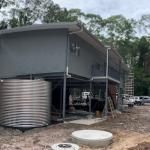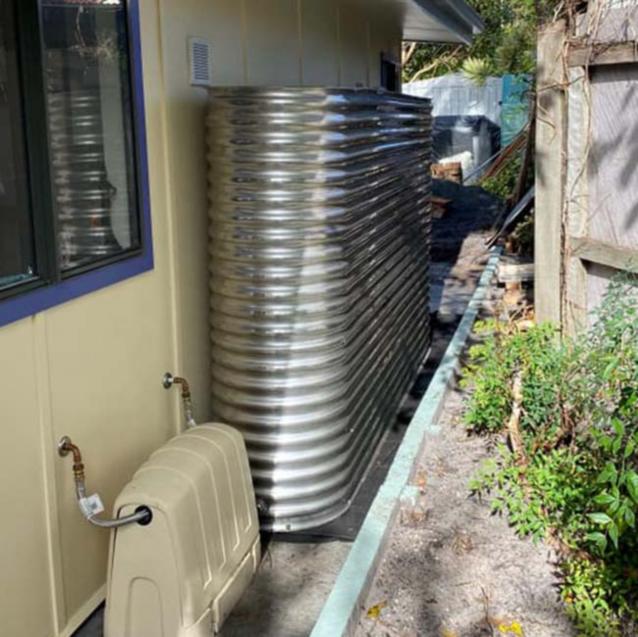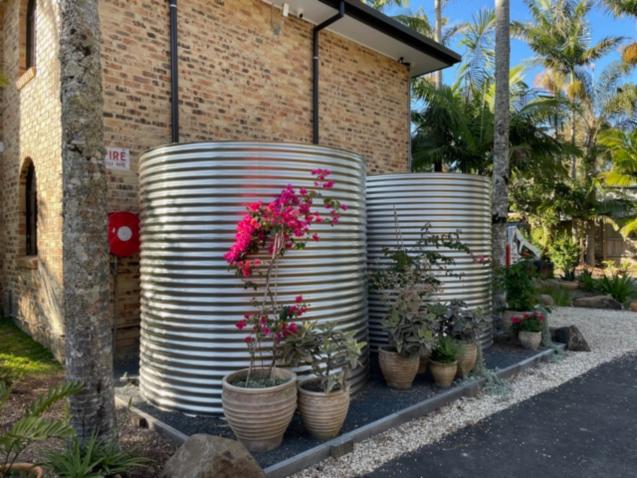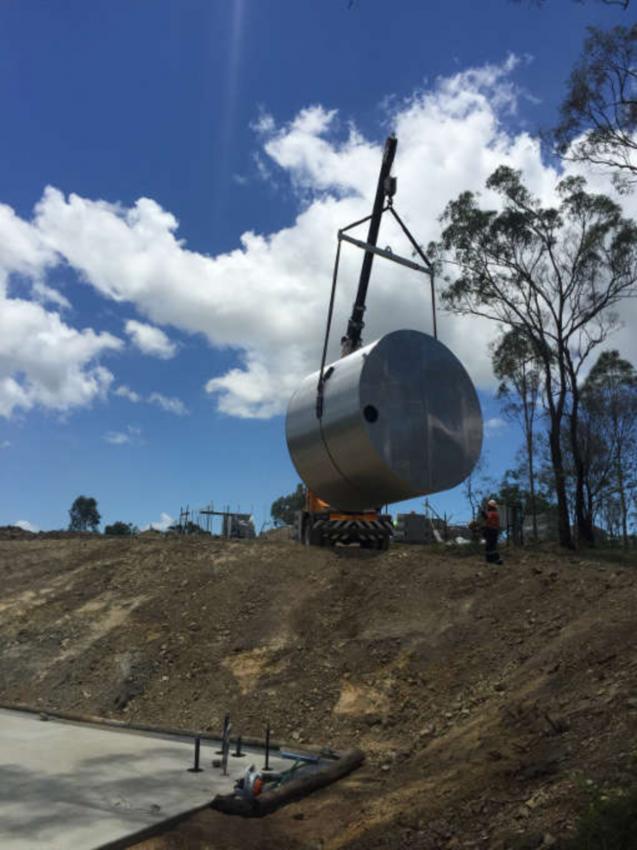
Choosing the right Location, Size, Shape and Material for your Water Tank
By Select Water Tanks|November 22, 2021
Before you invest in a Water tank for your home or business. You should always consider the following key factors that will insure you make the right choice for your own needs.
Tank Size
Wondering “ what sized water tank do I need? " It’s a good question, because the answers vary depending on how much water you use! Obviously, the bigger your water tank is, the more water you can store in it.
Water tanks can be custom made to a wide range of sizes. The rule of thumb is to purchase the largest tank possible (round or slimline) that you can, to fit into your intended location. This means you can capture and store a large quantity of water when it does rain. Measure up the space available and look at popular sizes or for no extra cost, choose to have one made to fit your intended location.
For Urban homes with limited space Water Tanks sizes from 2000 Litres to 5000 Litres are ideal. If you are looking to suppplement your mains water more for watering the garden, toilet flushing / laundry use and if you have the room, a 10,000 litre (2000 gallon) round tank is a popular choice to help you save on your water bills. Where you have the room, and on larger urban blocks of land, a 15,000 litre (3000 gallon) tank will supplement your mains water supply and provide you with enough water to use domestically for household purposes or for a substantial number of rural or horticultural needs.
The larger tanks 20,000 litre (4000 gallon) and above will provide you with enough water to enable you to substantially supplement your mains water supply and to enable you to start to be independent of your mains supply of water. Some Councils in fire prone areas have set this as a minimum size.
Tank Shape:
You need to decide whether it would be best for you to purchase a round or slimline water tank. Round tanks can be built to hold a larger volume of water while slimline tanks can be built to fit in a long, narrow space like along a wall, along a fenceline or under the eaves for example. Round tanks usually need a slightly larger footprint. Which shape better suits your situation?
Tank Composition and Appearance
You can choose your tank to be made from Colorbond/Aquaplate or Stainless Steel Water Tanks. This decision can have an impact on the location of your tank because you can get your Colorbond/Aquaplate tank made from a range of colours which can look very similar to, or deliberately contrast with, the colour of the surrounding structure(s). Many people however, are choosing their tank to be made from Stainless Steel so it can be located in a prominent place to look very elegant, typical Australian and as part of the deliberate design of the structure(s) around it.
On the other hand, some people may want to make their tank look less noticeable. To do this they may place it out of sight behind a structure, or surround it with bushes, or place it under or inside a structure. You need to give some thought to what you want the final appearance of your tank to look like, so you can decide on the best location to meet your needs.
Tank Footings
You need to consider a suitable location for your water tank in terms of what material you want to sit your tank on, so it is stable and secure. It is important to sit your water tank on a suitable base. This could be a concrete slab or compressed crusher dust or a wooden or steel platform or something that is strong and flat. You need to allow for the base to be slightly larger than the tank so that material around it does not erode or get damaged by activities such as water overflow or flooding.
Tank Connections
It make sense to locate your water tank close by to relevant infrastructure such as downpipes, an electricity outlet if you require a pump, and any existing pipes or hoses or plumbing accessories. This way the tank can be positioned to minimize the amount of connections needed for the inlet, the outlet and the overflow. Select Water Tanks can customise the design of your tank so that the inlet, outlet and overflow are best positioned to suit your site as well as add special outlets for fire-fighting purposes and other special fittings, like a bucket tap.
Tank Purpose
It also makes sense to locate your water tank as close as possible to its intended purpose. For example, near a garage if the water is to be used to wash cars and household objects, near the garden and/or lawn if for watering them regularly, or near a kitchen, laundry or bathroom if you intend to supplement your grey water system.
Overall
These are some of the major issues to consider when deciding where your water tank could be located. There could also be other factors to consider that are specific to your situation such as cost, accessibility and local council regulations. If you are looking to invest in a Water tank for your home or business please do reachout to us at Select Water Tanks, we will be happy to help you make the right choice.
Tank Size
Wondering “ what sized water tank do I need? " It’s a good question, because the answers vary depending on how much water you use! Obviously, the bigger your water tank is, the more water you can store in it.
Water tanks can be custom made to a wide range of sizes. The rule of thumb is to purchase the largest tank possible (round or slimline) that you can, to fit into your intended location. This means you can capture and store a large quantity of water when it does rain. Measure up the space available and look at popular sizes or for no extra cost, choose to have one made to fit your intended location.
For Urban homes with limited space Water Tanks sizes from 2000 Litres to 5000 Litres are ideal. If you are looking to suppplement your mains water more for watering the garden, toilet flushing / laundry use and if you have the room, a 10,000 litre (2000 gallon) round tank is a popular choice to help you save on your water bills. Where you have the room, and on larger urban blocks of land, a 15,000 litre (3000 gallon) tank will supplement your mains water supply and provide you with enough water to use domestically for household purposes or for a substantial number of rural or horticultural needs.
The larger tanks 20,000 litre (4000 gallon) and above will provide you with enough water to enable you to substantially supplement your mains water supply and to enable you to start to be independent of your mains supply of water. Some Councils in fire prone areas have set this as a minimum size.
Tank Shape:
You need to decide whether it would be best for you to purchase a round or slimline water tank. Round tanks can be built to hold a larger volume of water while slimline tanks can be built to fit in a long, narrow space like along a wall, along a fenceline or under the eaves for example. Round tanks usually need a slightly larger footprint. Which shape better suits your situation?
Tank Composition and Appearance
You can choose your tank to be made from Colorbond/Aquaplate or Stainless Steel Water Tanks. This decision can have an impact on the location of your tank because you can get your Colorbond/Aquaplate tank made from a range of colours which can look very similar to, or deliberately contrast with, the colour of the surrounding structure(s). Many people however, are choosing their tank to be made from Stainless Steel so it can be located in a prominent place to look very elegant, typical Australian and as part of the deliberate design of the structure(s) around it.
On the other hand, some people may want to make their tank look less noticeable. To do this they may place it out of sight behind a structure, or surround it with bushes, or place it under or inside a structure. You need to give some thought to what you want the final appearance of your tank to look like, so you can decide on the best location to meet your needs.
Tank Footings
You need to consider a suitable location for your water tank in terms of what material you want to sit your tank on, so it is stable and secure. It is important to sit your water tank on a suitable base. This could be a concrete slab or compressed crusher dust or a wooden or steel platform or something that is strong and flat. You need to allow for the base to be slightly larger than the tank so that material around it does not erode or get damaged by activities such as water overflow or flooding.
Tank Connections
It make sense to locate your water tank close by to relevant infrastructure such as downpipes, an electricity outlet if you require a pump, and any existing pipes or hoses or plumbing accessories. This way the tank can be positioned to minimize the amount of connections needed for the inlet, the outlet and the overflow. Select Water Tanks can customise the design of your tank so that the inlet, outlet and overflow are best positioned to suit your site as well as add special outlets for fire-fighting purposes and other special fittings, like a bucket tap.
Tank Purpose
It also makes sense to locate your water tank as close as possible to its intended purpose. For example, near a garage if the water is to be used to wash cars and household objects, near the garden and/or lawn if for watering them regularly, or near a kitchen, laundry or bathroom if you intend to supplement your grey water system.
Overall
These are some of the major issues to consider when deciding where your water tank could be located. There could also be other factors to consider that are specific to your situation such as cost, accessibility and local council regulations. If you are looking to invest in a Water tank for your home or business please do reachout to us at Select Water Tanks, we will be happy to help you make the right choice.



